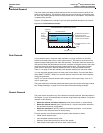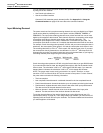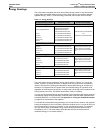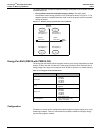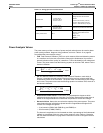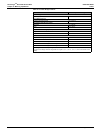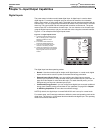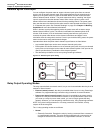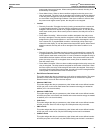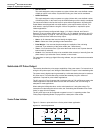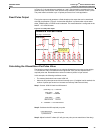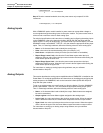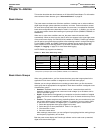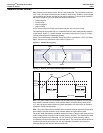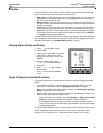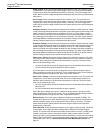
© 2011 Schneider Electric. All Rights Reserved.
63230-500-225A2 PowerLogic
TM
Series 800 Power Meter
3/2011 Chapter 5—Input/Output Capabilities
41
power meter loses control power. When control power is restored, the relay is not
automatically re-energized.
— Power Meter Alarm: When an alarm condition assigned to the relay occurs, the
relay is energized. The relay is not de-energized until all alarm conditions assigned
to the relay have dropped out, the power meter loses control power, or the alarms
are over-ridden using PowerLogic software. If the alarm condition is still true when
the power meter regains control power, the relay will be re-energized.
• Latched
— Remotely Controlled: Energize the relay by issuing a command from a remote
PC
or programmable controller. The relay remains energized until a command to de-
energize is issued from a remote PC or programmable controller, or until the power
meter loses control power. When control power is restored, the relay will not be re-
energized.
— Power Meter Controlled: When an alarm condition assigned to the relay occurs,
the relay is energized. The relay remains energized—even after all alarm conditions
assigned to the relay have dropped out—until a command to de-energize is issued
from a remote PC or programmable controller, until the high priority alarm log is
cleared from the display, or until the power meter loses control power. When control
power is restored, the relay will not be re-energized if the alarm condition is not
TRUE.
• Timed
— Remotely Controlled: Energize the relay by issuing a command from a remote PC
or programmable controller. The relay remains energized until the timer expires, or
until the power meter loses control power. If a new command to energize the relay is
issued before the timer expires, the timer restarts. If the power meter loses control
power, the relay will not be re-energized when control power is restored and the
timer will reset to zero.
— Power Meter Controlled: When an alarm condition assigned to the relay occurs, the
relay is energized. The relay remains energized for the duration of the timer. When
the timer expires, the relay will de-energize and remain de-energized. If the relay is
on and the power meter loses control power, the relay will not be re-energized when
control power is restored and the timer will reset to zero.
• End Of Power Demand Interval
This mode assigns the relay to operate as a synch pulse to another device. The output
operates in timed mode using the timer setting and turns on at the end of a power
demand interval. It turns off when the timer expires.
• Absolute kWh Pulse
This mode assigns the relay to operate as a pulse initiator with a user-defined number
of kWh per pulse. In this mode, both forward and reverse real energy are treated as
additive (as in a tie circuit breaker).
• Absolute kVARh Pulse
This mode assigns the relay to operate as a pulse initiator with a user-defined number
of kVARh per pulse. In this mode, both forward and reverse reactive energy are treated
as additive (as in a tie circuit breaker).
• kVAh Pulse
This mode assigns the relay to operate as a pulse initiator with a user-defined number
of kVAh per pulse. Since kVA has no sign, the kVAh pulse has only one mode.
• kWh In Pulse
This mode assigns the relay to operate as a pulse initiator with a user-defined number
of kWh per pulse. In this mode, only the kWh flowing into the load is considered.
• kVARh In Pulse
This mode assigns the relay to operate as a pulse initiator with a user-defined number
of kVARh per pulse. In this mode, only the kVARh flowing into the load is considered.



